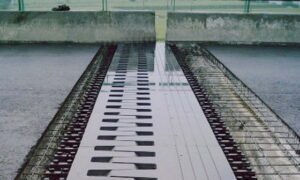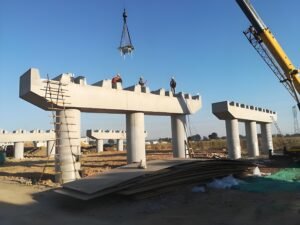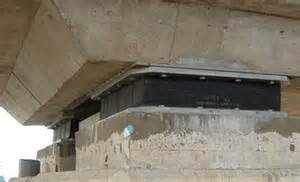Bridge articulation and bearing specification are essential aspects of bridge engineering, ensuring the longevity and functionality of bridges. This comprehensive guide delves into the importance of these elements, their various types, selection criteria, and best practices for maintenance and installation.
Understanding Bridge Articulation and Bridge Bearings
Articulation in bridge engineering refers to the strategic design and placement of supports and bearings that allow for necessary movements and rotations. This prevents undue stress on both the superstructure and substructure, ensuring that bridges can adapt to various forces and movements without damage.
How Does Bridge Bearing Work?
Bridge bearings work by transferring the loads from the bridge superstructure to the substructure while accommodating or restricting relative movements. These movements can include thermal expansion and contraction, as well as movements caused by traffic loads and wind forces. Bearings allow the bridge to flex and move without causing structural damage, maintaining the integrity and longevity of the bridge.
What Is Free Bearing Bridge?
A free bearing bridge is a type of bridge where the bearings allow movement in multiple directions without significant restraint. These bearings, often elastomeric or sliding bearings, permit the bridge superstructure to expand, contract, and rotate freely in response to thermal changes, load variations, and other forces. This design is typically used where the structure needs to accommodate large movements and rotations without imposing significant restrictions.
What Material Is Used for Bridge Bearings?
Bridge bearings are made from a variety of materials, chosen based on the type of bearing and the specific requirements of the bridge. Common materials include:
- Rubber and Steel: Used in elastomeric bearings, combining flexibility and strength.
- Polytetrafluoroethylene (PTFE): A low-friction material used in sliding surfaces of pot and spherical bearings.
- Stainless Steel: Often used in spherical bearings for its strength and resistance to corrosion.
- Bronze and Composite Materials: Occasionally used in specialized bearings for their unique properties.
Types and Functions of Bridge Bearings
Bearings are vital in transferring loads from the bridge superstructure to the substructure while accommodating or restricting relative movements. There are several types of bearings, each suited to different bridge configurations and requirements:
- Elastomeric Bearings: These are composed of layers of rubber separated by steel plates, commonly used in small structures. They handle movements through shear deformation and are economically efficient for applications with minor longitudinal, transverse, and rotational movements.
- Pot Bearings: These consist of a confined elastomer disc within a steel cylinder, allowing significant rotational movements. They can also accommodate translational movements when a sliding surface is included.
- Spherical Bearings: Used for large rotations, these bearings employ a spherical surface, often lined with PTFE, and matched to a stainless steel surface. They are more expensive due to the required machining and are typically used in major structures.
- Rocker Bearings: Allowing rotation around a single axis, rocker bearings provide torsional restraint around an orthogonal axis to the line of contact. They are often used in railway bridges where impact loading is high.
- Guide Bearings: These ensure the structure maintains the correct expansion/contraction path without bearing vertical loads, useful in heavily skewed or multi-span structures.
Key Considerations for Bridge Bearings and Articulation Design
Environmental and Load Factors
- Temperature Changes: Both uniform and differential temperature changes can induce significant movements and stresses in bridge structures.
- Concrete Shrinkage: The shrinkage of concrete components, such as the deck slab, must be accommodated to avoid undue stress.
- Permanent Actions: Dead loads and superimposed dead loads exert continuous forces that need to be managed.
- Variable Actions: Traffic loads are a primary variable action that bearings must accommodate.
- Vertical and Horizontal Loads: Both types of loads influence the choice and design of bearings.
- Support Settlements: Any movement or settlement of supports can induce additional forces and movements that bearings need to handle.
- Accidental Actions: Impacts from vehicular collisions or other accidents require consideration in bearing design.
Movement Accommodation in Bridge Bearings
Bearings must accommodate both permanent (irreversible) and transient (reversible) movements. This ensures that the bridge can adapt to various conditions without accumulating stress that could lead to damage.
Rotation Management in Bridge Bearings
Rotations about longitudinal and transverse axes at supports must be accounted for. These rotations can either be accommodated in the bearings or resisted by them. In some cases, rotation about a vertical axis, associated with plan bending, must also be considered, though this is usually minimal.
Horizontal Displacements in Bridge Bearings
Horizontal displacements arise from overall changes in structural length and bending. Proper bearing placement is crucial to manage these displacements, preventing undue stress and ensuring structural integrity.
Optimizing Articulation Arrangements with Bridge Bearings
Limiting Bearings and Expansion Joints
Reducing the number of bearings and minimizing movements to be accommodated by expansion joints decreases maintenance liabilities. This approach simplifies the structure and enhances its longevity.
Avoiding Uplift in Bridge Bearings
Preventing uplift at bearing positions, particularly in skewed structures, is essential. Uplift can complicate the design and increase costs, so it should be avoided whenever possible.
Mechanical Restraints in Bridge Bearings
Mechanical restraints are necessary to manage horizontal forces and ensure that thermal expansion and contraction occur correctly. These restraints should be strategically placed to control movements effectively.
Flexibility in Multi-Span Bridges with Bridge Bearings
Using slender piers that allow load sharing and flexibility prevents movement constraints in multi-span structures. This design consideration enhances the structure’s ability to adapt to various forces and movements.
Detailed Articulation Schemes for Bridge Bearings
Single Span Bridges
- Floating Articulation: In small bridges with minor horizontal forces, the deck can “float” on elastomeric bearings. These bearings accommodate all movements through shear deformation.
- Fixed Point Articulation: Most bridges require mechanical restraints to manage horizontal forces. Pot bearings and guided (unidirectional) bearings are used to control movements, with fixed bearings handling longitudinal forces.
Continuous Multi-Span Decks
For longer spans, the magnitude of movements increases. Placing the fixed bearing at the center of the bridge ensures that thermal expansion is distributed evenly, reducing stress on the structure. Pier design must account for horizontal forces resulting from braking and acceleration actions.
Curved Bridge Decks with Bridge Bearings
Curved decks can be guided either radially from a fixed point or tangentially to the radius of curvature. Radial guidance requires precise geometry for bearings, while tangential alignment effectively guides the deck around curves, accommodating horizontal forces with specific guide bearings.
Expansion Joints in Bridge Bearings and Articulation
Modern bridges use expansion joints to manage movements, preventing local cracking and maintaining structural integrity. Proper specification of these joints is crucial, similar to bearings, to ensure effective movement accommodation and maintenance minimization.
Bridge Bearing Specification and Installation
Bearing Schedule Preparation for Bridge Bearings
The bridge designer must prepare a detailed bearing schedule, listing forces, movements, and performance characteristics. This information helps the bearing designer determine the design values and full specifications.
Installation Considerations for Bridge Bearings
Bearings should be installed with precise orientation and temperature settings to accommodate full expansion and contraction movements. Taper plates may be required to align the bearing surfaces with the final geometry of the bridge.
Maintenance and Inspection of Bridge Bearings
Design for Accessibility in Bridge Bearings
Bearings must be designed for easy inspection, maintenance, and replacement. This includes providing access, means to relieve load, and physical space for extraction and insertion of new bearings.
Abutment Galleries for Bridge Bearings
At abutments, galleries facilitate the inspection and maintenance of bearings. These galleries provide necessary access and space to work on bearings without significant structural modifications.
Conclusion
Bridge articulation and bearing specification are fundamental to the functionality and longevity of bridges. By understanding and implementing optimized designs and maintenance practices, engineers can ensure that bridges remain safe, durable, and efficient for years to come. Proper articulation allows bridges to adapt to various forces and movements, while well-chosen bearings transfer loads effectively and accommodate necessary displacements and rotations. Through meticulous design, installation, and maintenance, the integrity and performance of bridge structures can be significantly enhanced.



